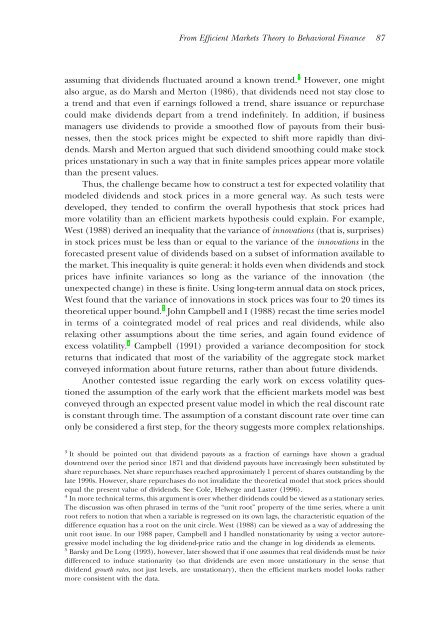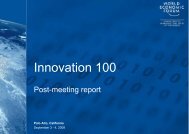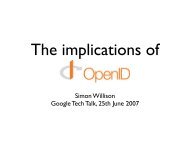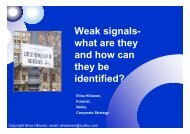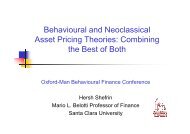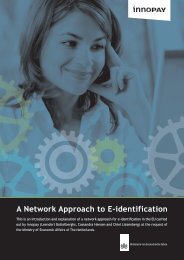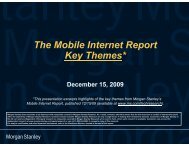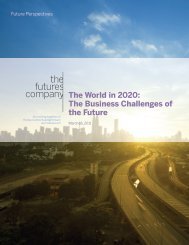From Efficient Markets Theory to Behavioral Finance
From Efficient Markets Theory to Behavioral Finance
From Efficient Markets Theory to Behavioral Finance
You also want an ePaper? Increase the reach of your titles
YUMPU automatically turns print PDFs into web optimized ePapers that Google loves.
<strong>From</strong> <strong>Efficient</strong> <strong>Markets</strong> <strong>Theory</strong> <strong>to</strong> <strong>Behavioral</strong> <strong>Finance</strong> 87<br />
assuming that dividends fluctuated around a known trend. 3 However, one might<br />
also argue, as do Marsh and Mer<strong>to</strong>n (1986), that dividends need not stay close <strong>to</strong><br />
a trend and that even if earnings followed a trend, share issuance or repurchase<br />
could make dividends depart from a trend indefinitely. In addition, if business<br />
managers use dividends <strong>to</strong> provide a smoothed flow of payouts from their businesses,<br />
then the s<strong>to</strong>ck prices might be expected <strong>to</strong> shift more rapidly than dividends.<br />
Marsh and Mer<strong>to</strong>n argued that such dividend smoothing could make s<strong>to</strong>ck<br />
prices unstationary in such a way that in finite samples prices appear more volatile<br />
than the present values.<br />
Thus, the challenge became how <strong>to</strong> construct a test for expected volatility that<br />
modeled dividends and s<strong>to</strong>ck prices in a more general way. As such tests were<br />
developed, they tended <strong>to</strong> confirm the overall hypothesis that s<strong>to</strong>ck prices had<br />
more volatility than an efficient markets hypothesis could explain. For example,<br />
West (1988) derived an inequality that the variance of innovations (that is, surprises)<br />
in s<strong>to</strong>ck prices must be less than or equal <strong>to</strong> the variance of the innovations in the<br />
forecasted present value of dividends based on a subset of information available <strong>to</strong><br />
the market. This inequality is quite general: it holds even when dividends and s<strong>to</strong>ck<br />
prices have infinite variances so long as the variance of the innovation (the<br />
unexpected change) in these is finite. Using long-term annual data on s<strong>to</strong>ck prices,<br />
West found that the variance of innovations in s<strong>to</strong>ck prices was four <strong>to</strong> 20 times its<br />
theoretical upper bound. 4 John Campbell and I (1988) recast the time series model<br />
in terms of a cointegrated model of real prices and real dividends, while also<br />
relaxing other assumptions about the time series, and again found evidence of<br />
excess volatility. 5 Campbell (1991) provided a variance decomposition for s<strong>to</strong>ck<br />
returns that indicated that most of the variability of the aggregate s<strong>to</strong>ck market<br />
conveyed information about future returns, rather than about future dividends.<br />
Another contested issue regarding the early work on excess volatility questioned<br />
the assumption of the early work that the efficient markets model was best<br />
conveyed through an expected present value model in which the real discount rate<br />
is constant through time. The assumption of a constant discount rate over time can<br />
only be considered a first step, for the theory suggests more complex relationships.<br />
3 It should be pointed out that dividend payouts as a fraction of earnings have shown a gradual<br />
downtrend over the period since 1871 and that dividend payouts have increasingly been substituted by<br />
share repurchases. Net share repurchases reached approximately 1 percent of shares outstanding by the<br />
late 1990s. However, share repurchases do not invalidate the theoretical model that s<strong>to</strong>ck prices should<br />
equal the present value of dividends. See Cole, Helwege and Laster (1996).<br />
4 In more technical terms, this argument is over whether dividends could be viewed as a stationary series.<br />
The discussion was often phrased in terms of the “unit root” property of the time series, where a unit<br />
root refers <strong>to</strong> notion that when a variable is regressed on its own lags, the characteristic equation of the<br />
difference equation has a root on the unit circle. West (1988) can be viewed as a way of addressing the<br />
unit root issue. In our 1988 paper, Campbell and I handled nonstationarity by using a vec<strong>to</strong>r au<strong>to</strong>regressive<br />
model including the log dividend-price ratio and the change in log dividends as elements.<br />
5 Barsky and De Long (1993), however, later showed that if one assumes that real dividends must be twice<br />
differenced <strong>to</strong> induce stationarity (so that dividends are even more unstationary in the sense that<br />
dividend growth rates, not just levels, are unstationary), then the efficient markets model looks rather<br />
more consistent with the data.


